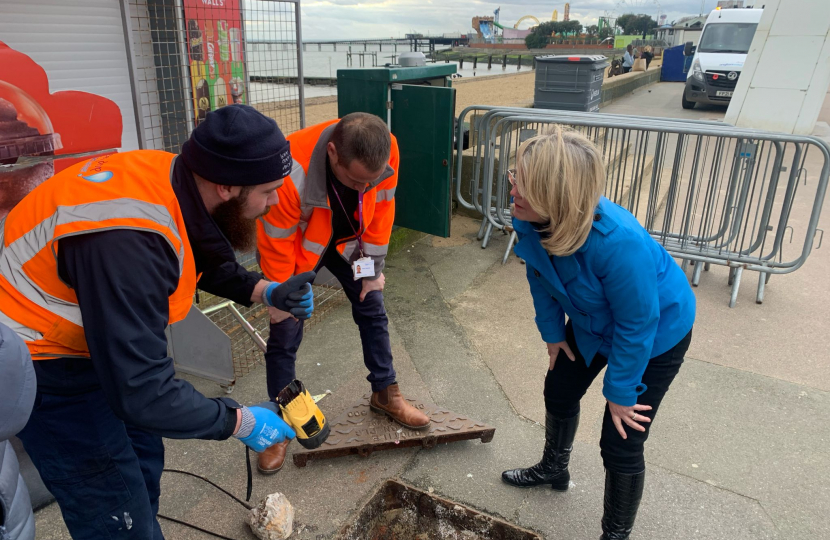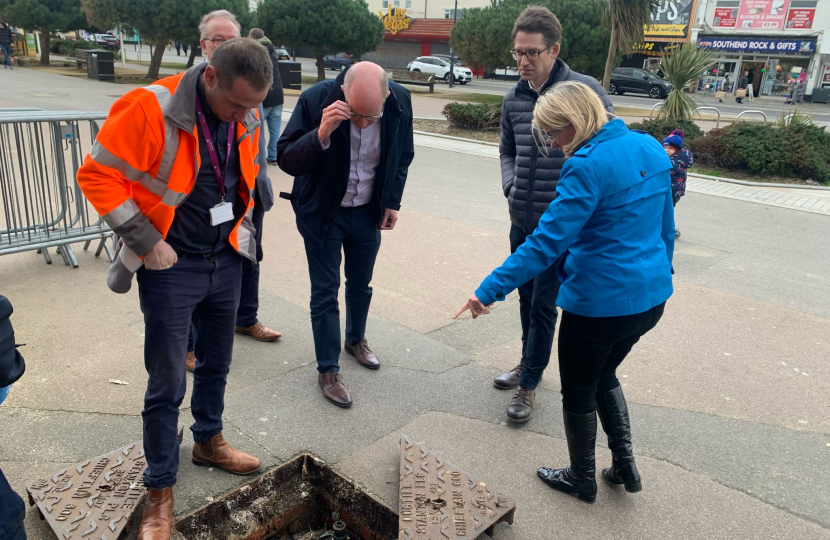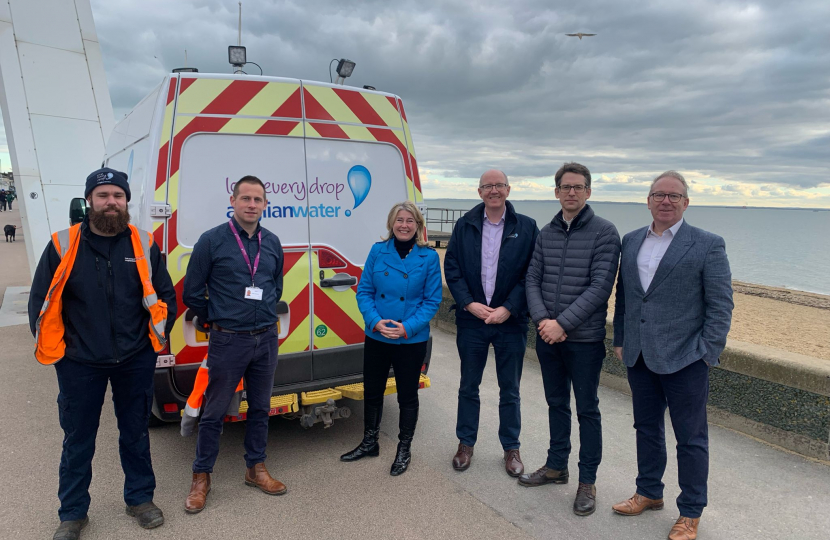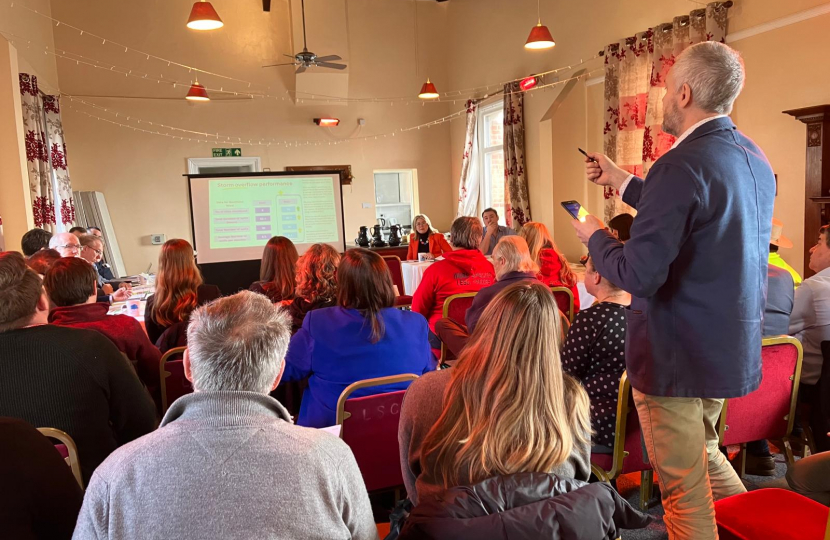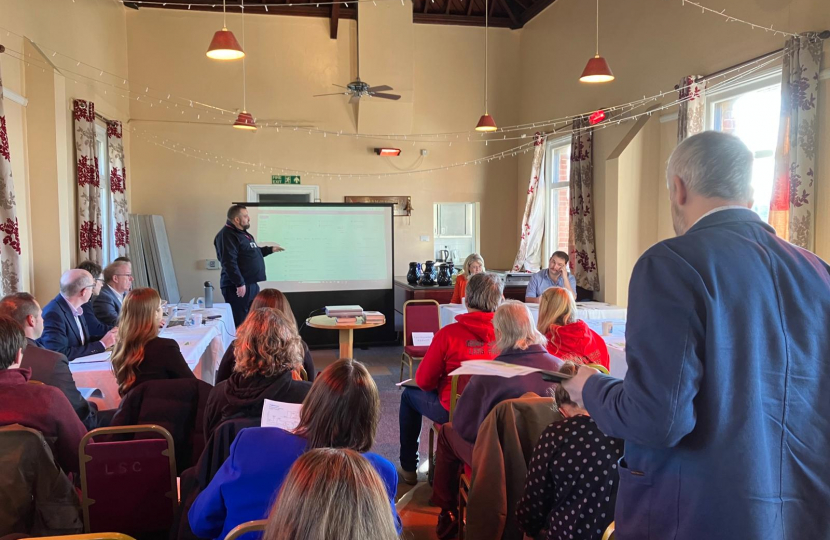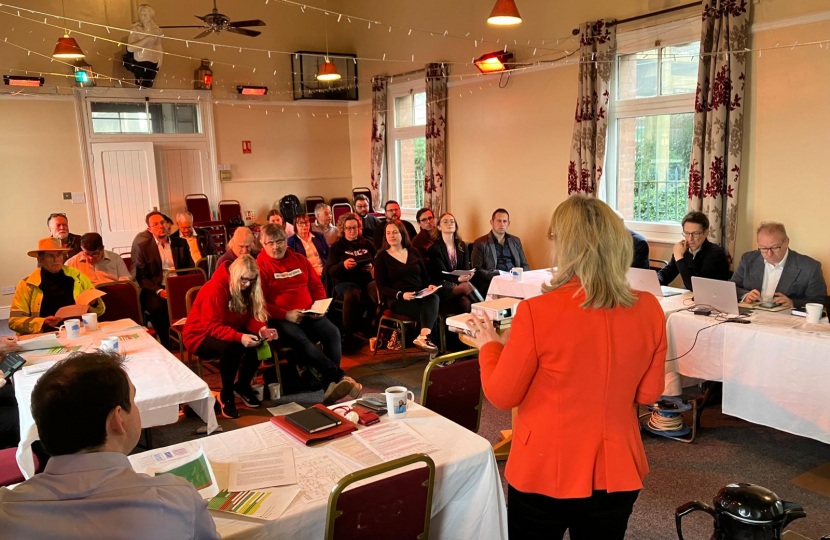On Friday 16th February at Leigh Sailing Club, I convened my fourth clean water and sewage summit. Residents, activists, councillors and concerned business owners filled every seat to discuss ongoing concerns about sewage overflows and to hear from a panel of six representatives from Anglian Water, headed up by Dr Robin Price, Director of Quality and Environment.
The Environment Agency declined, once more, to send a representative, so we left their chair at the front of the room, complete with place-name, vacant.
I began the meeting by drawing attention to the agreed action points from the third and previous meeting which took place in October 2023. I pointed out that out of ten agreed action points, Anglian Water had succeeded on just six. Two were marked as ‘unclear’ or ‘work in progress’ and two were unactioned.
Mark Lloyd, a Network Support Technician for Anglian Water presented a series of slides explaining how they monitored the network and overflows around Southend West. I queried the issues of the water monitoring alert system throwing up false alerts which mistakenly indicate sewage when there is none.
Anglian Water explained that rainfall impacts the total number of sewage spills. Dr Price drew attention to the fact that Anglian Water has increased from monitoring just 14, to 40 water overflow outlets in Southend in 2023. He pointed out that 2023 was a very wet year – the sixth wettest on record - compared to a comparatively dry 2022.
I was very pleased that Anglian Water is now monitoring every storm overflow in Southend and noticed that although the spills had gone up, the length of each spill had diminished. I questioned the data on which overflows were spilling for longer and asked when these figures would come down overall, and more importantly, when would it stop altogether?
Anglian Water said it was impossible to answer. Mark Lloyd said it would stop completely when there’s no excess surface water, no pipe blockages caused by people flushing wet wipes and putting fat down their drains, and no one misconnecting pipes during construction work. I felt I had to counter this robustly and told them that I was here to represent ordinary people who will look at the figures and feel angered and confused.
Anglian’s Regional Flood and Coastal Manager, Jonathan Glerum, talked more about storm overflows and said this system was devised to take excess water and take it away from homes and businesses and discharge it into rivers and seas. He said during a wetter year, there will be more spills and sadly that is unavoidable. But he stressed that the figures hadn’t ‘shot through the roof’ so he reasoned that improvements are working.
Anglian Water promised to come back in three months' time for my next water summit to present everyone with more data that ‘will show things are improving’.
I then wanted an explanation for the recent loss of the blue flag (to indicate clean water) in Thorpe Bay. Anglian Water said that very last sample of the year lost it the flag and prior to this sample it had been on track to retain its excellent classification. Heavy rainfall the night before the tests were done meant that dangerous levels of E coli and IE – Intestinal enterococci - were found in the water. On that note, Dr Price pledged to ‘control the controllables and pledge to improve everything else’.
Anglian Water presented to the room, their live storm overflow map - currently only live on the internal system in Anglian Water – where the dots turn from blue to purple in real time to indicate a storm overflow. The good news is that Anglian Water is working with Water UK trying to coordinate the launch of the map with’ all water colleagues’ and it should be ready in April 2024. Anglian Water confirmed that it will create user groups for local swimmers and surfers and will give them a push alert if it’s safe and clean to swim. It will also show if it’s spilling ‘red’ on a dry, non-rainy day as Anglian Water said it was aware that it needs to get onto these urgently.
In answer to questions from the floor, Anglian Water explained that not all spills have impacts on all beaches, it depends on tidal flow and that too will be shown on the map app. They’re putting simple cages in manholes to catch things that people flush down the loo and which block pipes causing problems.
Daniella Boon, in the audience representing the cold-water swimming group the Bluetits Chill Swimmers, welcomed the year-round water monitoring which Anglian Water said is starting imminently, as soon as by the end of Feb 2024. It will sample the eight bathing waters around Southend and samples will be taken by an accredited sampler and analysed in a lab. It will happen during the months that the Environment Agency don’t monitor (outside May to Sept) and they are also exploring the possibility of citizen-led approaches to water monitoring, using innovative testing kits.
I then opened up the presentation space to other attendees, Lottie Cooper from Natural England gave a presentation on the importance of protecting nature through sustainable development.
Cllr Meg Davison from Southend City Council – defended the Environment Agency saying they do good work, despite not coming to today’s meeting. I replied, saying that as they’ve failed to appear at two meetings they urgently need to come and engage in the same responsible way that Anglian Water does.
There then followed a ‘picture quiz’ round where Shah and Alex Haider from Southend against Sewage showed slides of malfunctioning drains gathered from their own personal monitoring of various storm overflows in Southend, and asked who owned which drains – Anglian Water or Southend City Council - and what exactly they were going to do about repairing the damaged ones?
Watching the slideshow which exposed pictures of pipes, grates and overflows at low tide, I demanded of Anglian Water if they couldn't just remove dangerous structures and blockages and what was the maintenance plan for their assets?
The Haiders showed a final pic of a drain that was free from blockages, well dug out underneath, clean and working well and said ‘this is all we’re asking for, this is what you (Anglian Water) can do when you do your jobs properly. This is all we are asking for.’
To sum up I heartily thanked all the contributors to the summit for engaging with me to make Southend an exemplar of what can be done when concerned people are brought together with the people who run the infrastructure to demand positive action.
We then went outside to the seafront for a walkabout where I was shown a new and interactive water butt and later I inspected a pipe cage system designed to catch potential pipe blocking materials before they reach the sewers.
My aim to bring together disgruntled constituents face-to-face with the water company bosses is paying off with both sides feeling that action is being taken and promises kept. I look forward to our next summit!

